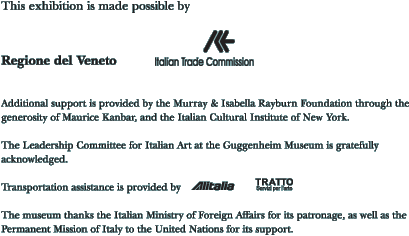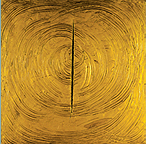
Lucio Fontana (1899–1968) dedicated his career to investigating the concept of space and a new iconography: the void and the cosmos, with the vortex as a representation of the dynamic principle. He pushed at the boundaries of art through a precocious awareness of new technology, such as neon and UV light, and new media such as television. In order to introduce these avant-garde concepts, Fontana wrote several manifestos, in which he defined his artistic research in terms of a spatialist movement, known in Italian as Spazialismo, which he founded in Italy in 1947. Trained as a sculptor, he introduced the third dimension to his canvases first by puncturing them with holes in 1948 and then, from 1958, by performing his most famous gesture: the Cut. He called these works Concetti spaziali, or spatial concepts.
There has not been a major exhibition of Fontana's work since the Solomon R. Guggenheim Museum’s retrospective in 1977. Now, nearly thirty years later, the present exhibition—which premiered at the Peggy Guggenheim Collection, Venice—introduces a selection of work ranging from 1947 to 1965 and brings together for the first time two rare series that Fontana produced in the early 1960s, each dedicated to the city that inspired its creation: Venice and New York.
In 1961, Paolo Marinotti, owner of the exhibition center at Palazzo Grassi, Venice, invited Fontana, along with artists Jean Dubuffet, Mark Rothko, Sam Francis, and others to participate in an exhibition entitled Arte e Contemplazione. Fontana immediately set to work on a number of canvases, lavishing thick paint over their surfaces to evoke the sensual richness of Venice. He manipulated the paint with his fingers and various instruments to make furrows and whip up vortices that allude to the sky of Venice, or to the Baroque whorls of Venetian churches, or to the patterns formed by water in moonlight. Scattered fragments of Murano glass cast colored shadows that evoke the delicacy of Veneto-Byzantine mosaics.
The Venice paintings dazzled the public. Martha Jackson offered to show them in her New York gallery, and in November 1961 Fontana traveled to New York to attend the opening of his first solo exhibition in the U.S.: Lucio Fontana, Ten Paintings of Venice. He was immediately captivated by Manhattan’s skyline: "New York is more beautiful than Venice!" After choosing metal as the sublime medium in which to realize his ideas, he formed the drawings he made in New York into the basis for an extraordinary series of works. Fontana, scratched, pierced, and slashed sheets of copper or aluminum to express this dynamic metropolis.
Presenting these two rare bodies of work together for the first time, Lucio Fontana: Venice/New York conveys a unique personal conception of two cities to their respective publics and is the most comprehensive presentation of Fontana's work from this period.

 |
 |


ABOVE LEFT: Lucio Fontana, Concetto spaziale, New York 14, 1962. Lacerations and scratches on aluminum, 77 3/16 x 37 13/16 inches [62 ME 3]. Courtesy Fondazione Marconi, Milan. © 2006 Fondazione Lucio Fontana
ABOVE RIGHT: Lucio Fontana, Concetto spaziale, Venice Was All Gold (Concetto spaziale, Venezia era tutta d’oro), 1961. Oil and cut on canvas, 59 1/16 x 59 1/16 inches [61 O 38]. Museo Thyssen-Bornemisza, Madrid. © 2006 Fondazione Lucio Fontana
|